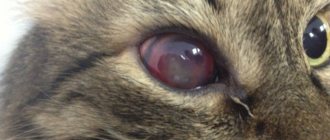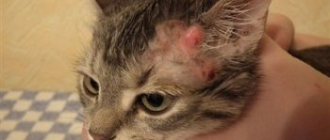Carrying out complex tests to detect infections in cats A full range of diagnostic equipment at the clinic 24-hour operation
The issue of infection in cats worries every responsible owner, especially since throughout its life the animal’s body can encounter a huge number of infections and many of them require serious and long-term treatment.
Panleukopenia
This disease is popularly called feline distemper. The causative agent of the infection is a virus from the genus parvovirus, which has a pathological effect on the gastrointestinal tract and also causes significant changes in the entire body of the animal. The disease spreads very easily and is difficult to treat. The younger the animal and the weaker its body, the less chance it has of recovery.
This infection of cats is transmitted through direct contact with carrier animals or with environmental objects. Here, owners often ask how their cat, who lives exclusively at home, could get sick. The answer is simple: often the owners themselves become unwitting carriers of a dangerous virus, because they can bring it on their clothes and shoes.
The incubation period, that is, the time from infection to the appearance of the first clinical signs, is quite short and is only 2-10 days. Here, a lot also depends on the degree of contact with the virus and the immune strength of the animal’s body.
Panleukopenia occurs hyperacutely and subclinically. In hyperacute and acute cases, which are most often recorded in young cats, symptoms are associated with severe depression, increased body temperature, refusal to eat, and pain in the abdominal area. A little later, vomiting and diarrhea of varying severity appear. Among other things, dehydration is observed, and purulent exudate may be released from the eyes and nose. In hyperacute and acute forms, the death of the animal can occur within the first few days after the onset of clinical symptoms. With a subclinical course, which can most often be found in adult cats, the symptoms of infection are smoothed out and can often go unnoticed.
Diagnosis of this infection in cats is complex. When contacting a veterinary clinic in Moscow, the owner must be prepared to tell the doctor what has happened to the animal recently, with whom it has been in contact, whether annual vaccinations have been carried out, etc. In addition to collecting an anamnesis and a general examination of the animal, the doctor will need to take cats blood for analysis. With panleukopenia, a significant decrease in leukocytes is almost always observed. Accurate confirmation of the suspected diagnosis can be obtained using serological tests (ELISA and PCR diagnostics).
As for treatment, there is no single scheme, since the selection of drugs is carried out solely depending on the condition of a particular animal. Most often, the regimen includes the use of antibiotics, intravenous infusions, vitamin complexes, etc. The duration of treatment depends on how well the cat responds to therapy and at what stage the disease is. Naturally, in this case, an important role is played by the age of the animal, the general condition of its body, and the conditions of detention before and during the illness. Unfortunately, even the most serious therapy may not produce positive results.
When it comes to cat panleukopenia, the most important and correct method of control is prevention, namely timely vaccination, which, unfortunately, many owners neglect. Today, almost all vaccines contain antibodies to feline parvovirus in their complex, so when visiting a clinic in Moscow for vaccination, owners care not only about the health, but also about the life of their beloved pet.
How about a kitten exam?
All kittens should be tested and vaccinated against FLV as recommended by the veterinary community. Consult your veterinarian regarding this matter.
In the case of VLK, there is no age limit for this analysis; this can be done in
any time. The test requires only a few drops of blood. And it can detect the virus in kittens as young as 4-5 weeks old. Kittens that test negative for FIV antibodies are likely not infected, but will need to be tested again a few months after you get them. A positive test in kittens under 6 months of age may only be a temporary result of antibodies transferred from an infected mother or may represent a true infection. Repeated testing over time will likely be needed to look at the infection over time.
Calcivirosis
An infection in cats that is quite highly contagious, but, unlike panleukopenia, has a much more favorable course.
Like many other infections, the course of the disease directly depends on the age and immune status of the animal. Small kittens and old animals suffer more severely from calcivirosis. The incubation period for this type of virus takes 2-10 days. The disease occurs in acute and subacute forms, and subclinical progression of the disease is also possible. Many animals remain carriers and are capable of infecting other susceptible cats throughout their lives.
Transmission of the virus is possible through direct contact with sick animals or carrier cats, as well as through the air, through hygiene items, etc. That is, in this situation, the owner of the animal may well become a carrier of the virus.
Symptoms of calcivirus infection in cats are as follows: increased body temperature, purulent discharge from the eyes and nose, the nasal mucosa is swollen, increased salivation is observed, the animal refuses food, is depressed, hyperemic areas appear in the mouth on the mucous membrane and tongue, eventually turning into ulcers. Lack of appetite and the inability to consume liquid, coupled with an elevated body temperature, can lead to dehydration, which greatly aggravates the course of the disease. During illness, the animal often sneezes, thereby spreading the virus into the environment. In addition to the oral cavity, ulcers can form on the nasal planum, lips and face of the animal. If the infection of cats is protracted (more than 7 days), and the sick animal is in the so-called “risk group” (small kittens, old cats, animals with chronic diseases or concomitant viral infections), then complications such as bronchitis or pneumonia. Naturally, with such a course, the prognosis for recovery is cautious.
Diagnosis of calcivirus infection in cats is complex. Most often, already during a clinical examination of the animal and taking an anamnesis, the veterinarian already assumes the presence of calcivirosis, but additional studies are needed to confirm it (CBC, biochemical blood test, ELISA and PCR diagnostics). If the course of the disease is severe, then x-ray diagnostics may be required to exclude pneumonia.
Treatment, as with other cat infections, is complex and depends on the stage of the disease and the severity of its course. The treatment regimen contains antibacterial agents, vitamin complexes, local agents for treating ulcers in the mouth and on the nasal tract, drops in the eyes and nose. Most often, if the course of the disease is favorable, treatment can be carried out at home, however, it must be agreed upon and regularly monitored by a veterinarian.
Just like panleukopenia, calcivirosis is easier to prevent than to treat. The component against this infection is included in most complex vaccines. However, it is worth remembering that calcivirus has about 40 different strains and sometimes the vaccine may not provide 100% immunity, but a vaccinated animal will survive the disease much easier than an unvaccinated one.
Infectious feline pancreatitis
This is a deadly disease that especially threatens those cats that are kept collectively, that is, they are not the only ones in the house. This means that the greatest risks exist for shelters, nurseries, or simply numerous cats that are kept in one house or apartment.
The insidiousness of the virus that serves as the source of the disease is that it easily degenerates from a form that is not life-threatening to a cat, into a form that poses a mortal threat to the life of the cat. At the same time, it is possible to determine the fact of transition from one form to another when it is too late.
An accurate diagnosis can be made solely based on test results, since infectious feline pancreatitis can easily be confused with various diseases: cardiovascular, gastrointestinal, musculoskeletal.
Unfortunately, today there is no guaranteed method of treating this disease, and the vaccine against this disease is practically useless; scientists are even inclined to believe that this vaccine is harmful.
Rhinotracheitis or feline herpes virus infection
Another virus that affects the upper respiratory tract in cats. Cats of any age are susceptible to this virus, however, as always, young, weakened and old animals are more seriously ill.
Rhinotracheitis is transmitted by airborne droplets, as well as with urine, feces, and discharge from the eyes and nose. Infection occurs quickly, clinical signs may appear after 3-7 days.
Symptoms include increased body temperature, depression, lack of appetite, and copious discharges appear from the nose and eyes, first serous and then purulent. The animal sneezes, its voice disappears or obvious hoarseness appears. In mature, strong cats, the rhinotracheitis virus can occur in a mild form, when the clinical signs include only rapid sneezing. However, even with a mild form of the disease, a cat can remain a carrier of the virus for the rest of its life and infect other animals, including transmission of the virus in utero and through mother’s milk.
Diagnostics includes examination, medical history, laboratory blood tests, PCR diagnostics, and, if necessary, X-ray examination.
Treatment is symptomatic. Most often these are antiviral and antibacterial drugs. To alleviate the animal’s condition, the nasal passages must be cleared of accumulated contents (nasal rinsing), and drops must be used to reduce swelling.
The prognosis is favorable in most cases, but severe complications may occur in weakened animals.
Prevention of rhinotracheitis is timely vaccination and compliance with sanitary standards for keeping animals.
Feline viral leukemia
This pathology is quite common and is one of the causes of neoplasms in cats.
Transmission of the virus from a sick animal to a healthy one occurs through saliva during active licking or biting. However, contact with a sick animal does not always become a death sentence for a healthy animal. After entering the body, the virus can be eliminated, that is, disappear; the level of the animal’s immune system plays an important role here. If this does not happen, then the virus spreads through the lymphoid tissue throughout the animal’s body and, after reaching the bone marrow stem cells, can either remain there in a latent state or cause persistent viremia. The trigger for the virus to emerge from its latent state can be any stress factor or the use of increased doses of corticosteroids in the treatment of animals.
Clinically, the virus manifests itself as persistent anemia, anorexia, weight loss and the appearance of malignant neoplasms. In terms of prevalence in animals with VIL, various lymphomas (mediastinal, nutritional, etc.) lead.
Depending on the location of the tumor, there may be a wide variety of clinical manifestations of the disease - persistent diarrhea, vomiting, nervous phenomena and much more.
Diagnosis based on the clinical picture of blood cannot be definitive, although it largely indicates the presence of a virus in the animal’s body. Finally, the feline leukemia virus can be determined by serological methods, which, unlike many other viruses, have virtually no false-positive results.
There is no treatment for animals with clinical manifestations of VIL; only palliative therapy is possible, which will be aimed at combating concomitant infections and maintaining the animal’s quality of life.
There is a definite opinion among experts regarding treatment. Thus, it is believed that if the leukemia virus is accidentally detected in an animal without any clinical signs, it is not worth starting treatment, but it is necessary to re-diagnose it after 12 weeks. Most often, repeated diagnostics will give a negative result.
In animals with clinical signs, treatment is aimed at stabilizing red blood (combat anemia), as well as eliminating concomitant infections. When neoplasms are detected, which most often turn out to be lymphoma, chemotherapy is used, which can bring a fairly good result.
Prevention of VIL is aimed at controlling the keeping of animals, that is, to prevent infection, cats should not be kept crowded, all newly arrived animals should be examined and kept for a certain time in quarantine conditions.
There is a vaccine against feline viral leukemia, however, before administering it, it is strongly recommended to conduct a study for the presence of the specified virus in the animal’s body. If the test result is positive, then you need to wait 3-4 weeks and then repeat the test again. Most often, it will give a negative result and the cat may be susceptible to vaccination, although, most likely, an immune response has already formed in its body.
Relieve suffering or try to prolong life
Incurable diseases in cats are often very difficult and accompanied by painful sensations. Further measures to resuscitate and prolong life can only bring continued suffering. There are situations in which it is more humane not to force the animal to suffer, but to carry out euthanasia.
We remind you that our article is for informational purposes only. For professional help, the owner should contact the attending veterinarian and follow his recommendations. Health to your animals!
We invite you to discuss the article. Share your opinion, ask questions, talk about your experience of keeping cats.
Zooanthroponoses - rabies
There is a lot of talk about this virus, but, nevertheless, cases of rabies among cats occur with terrifying regularity. The worst thing about this virus is that it is dangerous for humans and, in the absence of an adequate and timely response, can be fatal. In animals, rabies is 100% fatal.
Any mammal, at any age, can get this virus. Clinical manifestations of the virus can be very diverse, but most often changes in behavior are observed - the cat becomes more affectionate, climbs into the arms, licks the owner’s hands, and caresses. Sometimes an animal, on the contrary, becomes inadequate - it loses its sense of fear, it treats everyone around them aggressively and often attacks its owner. At the stage of clinical manifestations, the amount of virus in the animal’s body is quite high. Transmission occurs when the saliva of a sick animal comes into contact with an open wound or mucous membrane of a healthy one. That is, you can become infected through a bite or excessive licking. As the virus develops in the animal’s body, its clinical signs increase, photophobia and hydrophobia appear, salivation increases, and paralysis occurs. In fact, clinically rabies can be very different, but it almost always includes the presence of nervous phenomena.
The final diagnosis of rabies is only postmortem, it occurs in the laboratory - the brain of a dead animal is used for research, if the result is negative, then experimental infection of laboratory animals is carried out. Serological diagnostic methods also exist, but many experts have doubts about their reliability.
There is no treatment - an animal suspected of rabies is isolated and observed for 10 days; if during this period the animal does not die, then it probably has another disease that is clinically similar to rabies.
There is only one way to prevent this virus: timely and regular vaccination. Moreover, in addition to commercial vaccines, there are also budget ones. If an animal is not vaccinated, the owner faces administrative liability.
Feline viral peritonitis
Another disease characterized by high mortality. The cause of this pathology is coronavirus, however, the presence of coronavirus in a cat’s body does not always lead to the development of viral peritonitis.
At the moment, it is believed that the cause of viral peritonitis or VIP is a mutation of the intestinal coronavirus in the body of a particular animal.
Coronavirus infection occurs through nutrition, so animals that are kept in crowded conditions, show animals, or those that have free range are always at risk. When coronavirus enters the body of a healthy cat, it develops signs of mild enteritis (mild diarrhea, slight lethargy and decreased appetite); most often, such phenomena go away on their own and do not cause concern to owners. During subsequent medical examination of the animal or during diagnostics “for another reason”, antibodies to the coronavirus infection of cats may be detected in the animal’s blood. This indicates that the animal has successfully recovered from the coronavirus and can be its lifelong carrier. It is worth saying that at the age of 2-3 years, almost all animals already contain antibodies to this virus in their blood, which means their immunity has successfully suppressed the virus. However, sometimes, under unfavorable conditions (stressful situations, age-related decrease in immunity, use of corticosteroids in high doses, the appearance of concomitant infections), a mutation of the virus occurs and signs of peritonitis appear. Viral peritonitis comes in two forms: dry and wet. The first is characterized by persistent weight loss, anorexia, nervous phenomena (convulsions, vestibular disorders, ataxia, paralysis, paresis), pathological processes in the kidneys, liver and gastrointestinal tract.
The exudative or wet form is characterized by the appearance of ascites and/or effusion into the pleural cavity, difficulty breathing, weight loss, fever, lethargy, decreased appetite, the appearance of nervous phenomena and disruption of the kidneys, liver and gastrointestinal tract.
There is no treatment for clinical manifestations of peritonitis, all help is symptomatic and is aimed at improving and maintaining the quality of life of the animal - fluid from the abdominal and thoracic cavity is pumped out as necessary, a course of antibiotic therapy is carried out aimed at combating secondary pathogenic microflora, antispasmodics, immunostimulants are used drugs, however, most often this treatment can help the animal only for a very short time.
Diagnosis of VIP is carried out clinically and is also confirmed using serological methods.
Prevention consists of following the rules for keeping animals, and there is also a vaccine against feline coronavirus, but its use raises many questions among specialists, since most cats are already exposed to this virus in childhood and the body successfully copes with it.
Bacterial infections in cats
Using vaccinations to fight serious diseases
Historically, veterinarians have recommended annual vaccinations against most infectious diseases in cats. In recent years, there has been a tendency to avoid vaccinations that may not be entirely necessary. Instead of annual vaccination, some authorities advocate pre-vaccination testing to measure levels of protective antibodies. Serology (measuring the level of specific antibodies against a specific infection) may be used in place of annual FVRCP vaccination. Several studies have shown that measuring antibody levels against these viruses is a good indicator of the immune status of most cats and their ability to resist infection.
The decision to vaccinate or test antibody titers prior to vaccination is based on a number of factors. You need to consult with your veterinarian to decide whether to get tested or have annual vaccinations.
If you have any questions or concerns, you should always visit or call a qualified veterinarian—this is your best opportunity to ensure the health and well-being of your pets.
Chlamydia
Chlamydia is an infection that most often causes acute conjunctivitis in cats. The most susceptible are kittens, to whom the disease is transmitted in utero, but adult animals can also be infected.
General clinical manifestations of this disease are mild symptoms of damage to the upper respiratory tract in the form of increased sneezing and pathological nasal discharge, some sources indicate periodic vomiting and diarrhea, but the leading sign of chlamydia is unilateral or bilateral conjunctivitis. Copious serous or purulent contents are discharged from the eyes, blepharospasm and swelling of the conjunctiva are noted. In this case, infection occurs from animal to animal through the genitourinary and gastrointestinal systems. When adult animals are infected, the determining factor is crowded housing and the use of only hygiene items.
Diagnosis of chlamydia in cats is possible using different methods, the value of each of which varies depending on the stage of the disease. Thus, with early diagnosis, 4-7 days after infection, bacterial inclusion bodies can be detected in scrapings from the conjunctival mucosa. Serological studies are indicative when carried out over time, that is, within 4 weeks after the suspected infection, an increase in antibody titer is observed. The main and highest quality method today is PCR diagnostics.
Treatment of animals with chlamydia is possible and carried out with long-term antibiotic therapy.
The main and most optimal preventive measure is vaccination, which provides complete protection throughout the year. In addition, general preventive measures should be followed, such as: compliance with zoohygienic maintenance requirements, quarantine of new animals and regular medical examinations.
Leukemia virus
Infection with this virus can lead to suppression of the cat's immune system and can also lead to cancer. About ninety percent of cats die within a maximum of four years after infection.
It should be understood that there is no effective treatment for the disease; you can only support your pet by relieving the symptoms of the disease and alleviating its condition. The use of immunomodulators is especially indicated to help the cat.
To prevent the disease, the use of vaccination has been proven today.
Mycoplasmosis
Another bacterial infection of cats, the main manifestation of which is lesions of the conjunctiva of the eye. Mycoplasma is considered an opportunistic bacterium that can cause clinical disease.
The main symptoms of mycoplasmosis:
- hyperemia and swelling of the conjunctiva;
- serous and serous-purulent discharge from the eyes;
- increase in body temperature;
- apathy and loss of appetite;
- signs of damage to the upper respiratory tract;
- abortions and stillbirths.
Diagnostics is carried out by ELISA and PCR methods. Antibiotic therapy is used as treatment. Prevention is the observance of standards for keeping and feeding animals.
Symptoms
The list of infectious diseases of cats is very long, but the first symptoms of the disease may be of a similar nature. The main features include:
- increased lacrimation:
- heavy salivation;
- vomiting, diarrhea;
- copious discharge from the nose;
- inflammation of the eye;
- cough, sneezing;
- the desire to hide from bright light, attempts to constantly be out of sight of the owners;
- fear at the sight of water;
- a sharp loss of interest in food or, conversely, a greatly increased appetite;
- general lethargy, apathy;
- temperature;
- rash and wounds on the head and torso;
- convulsive twitching of the limbs and the whole body.
If a cat is infected, it depends only on the person whether it will be possible to save the pet by starting treatment at the initial stage of the disease, because infectious diseases are quite difficult to treat effectively.











